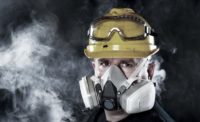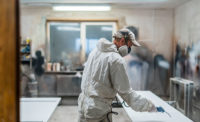In many of today's workplace environments, a respirator and a proper respirator fit test are critical components of the employee respiratory protection program. Fire service, as well as industrial companies and healthcare professionals, have come to depend on properly fitting respirators for protection from respiratory (inhalation) hazards, such as physical, chemical, and biological hazards. When implemented correctly, a respirator fit testing as part of a written respiratory protection program can help ensure that safe respiratory protection levels are achieved through a properly sized and donned respirator. Passing a quantitative respirator fit test verifies that the respirator is a good size and is donned correctly, as well as provides for a valuable opportunity for training employees about achieving the correct mask fit.
As outlined by OSHA, a "fit test" tests the seal between the respirator's facepiece and your face. The test is required to be performed at least annually for those required to wear a respirator for their job.
Modified CNC Protocols
OSHA recently announced changes to its Respiratory Protection Standard. The changes affect the Ambient Aerosol Condensation Nuclei Counter (CNC) Quantitative Fit Test (QNFT) Protocols in 29 CFR 1910.134, Appendix A. These changes took effect on September 26, 2019.
The new protocols are based on three studies published in a peer-reviewed journal, demonstrating the test equivalency to the original Ambient Aerosol CNC QNFT protocol. In their final rule document, OSHA said that the new protocols "will maintain safety and health protections for workers while providing additional flexibility and reducing compliance burdens."
HOW THE RESPIRATORY PROTECTION STANDARD CHANGED
The modified CNC protocols are now faster, are completely automated, and more streamlined compared to all other fit test methods. The new protocols require fewer, shorter fit test exercises. Instead of eight exercises, the new rules require four. Total fit test time is reduced from 7:15 minutes to 2:29 minutes.
Previously, CNC fit test protocols required a series of eight test exercises, performed in the following order: normal breathing, deep breathing, turning head side to side, moving head up and down, talking, grimacing, bending over, and then normal breathing again.
The new modified ambient aerosol CNC protocol for full-face piece and half-face piece elastomeric respirators is different from the original protocol in that:
It includes four of the eight original test exercises (bending over, jogging, head side to side, and head up and down).
The new modified ambient aerosol CNC protocol for filtering face piece respirators differs from the original protocol as follows:
It includes four of the eight original test exercises (bending over, talking, head side to side, and head up and down).
The fit test compliance recordkeeping remains the same, but by reducing the number of exercises and per exercise time, the total time needed for a fit test is drastically reduced. OSHA believes the new rules will end up saving employers considerable time and money.
HOW TO MAKE RESPIRATOR FIT TESTING 65% FASTER
Respirator fit testers using the modified CNC protocols such as the PortaCount® Respirator Fit Tester, are now nearly twice as fast as instruments using the controlled negative pressure (CNP) REDON protocol and 65% faster than the original CNC protocols. Whether fit testing medical teams, industrial workers, or first responders, respiratory protection programs will benefit. The test remains rigorous, is fully automated, and provides quantitative fit testing across all respirator types. It also dramatically increases the number of people you can fit test in a set time with no compromises on safety and health.
EMPLOYER ADOPTION
The rule does not require an employer to update or replace its current fit testing methods if the fit testing methods currently in use meets existing standards. However, OSHA believes these new modified variations of the ambient aerosol CNC fit testing protocols gives employers greater flexibility and reduces the burdens of complying with OSHA's respiratory protection standard.
STATE ADOPTION
States administering their own workplace safety and health programs are not required to adopt the modified protocols. OSHA does strongly encouraged states to implement the new protocols to provide employers additional compliance options.
Frequently Ask Questions To start using the new protocols:
Do I have to change my program or procedures?
No, with the new protocols, you select the mask you are testing and the protocol matching that mask. How you use the instrument and the outcome of a fit test is the same; the test is just quicker.
Do I need to redo old fit tests?
No, this is simply a modification to the existing protocol. Fit tests using the previous eight-step protocol are still valid. The only difference is that now there is an option for a shorter test going forward.
How do the new protocols make more workers safer?
This shorter and simpler fit test makes compliance easier without compromising worker safety. An easier path to compliance means more workers will pass quality fit tests, increasing compliance rates, and overall worker safety.
Learn more about the modified CNC protocols or the PortaCount® Respirator Fit Tester.



